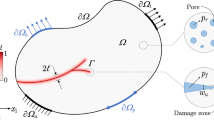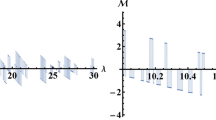Abstract
A finite element method is proposed that can capture arbitrary discontinuities in a two-phase medium. The discontinuity is described in an exact manner by exploiting the partition-of-unity property of finite element shape functions. The fluid flow away from the discontinuity is modelled in a standard fashion using Darcy’s relation, while at the discontinuity a discrete analogon of Darcy’s relation is proposed. The results of this finite element model are independent of the original discretisation, as is demonstrated by an example of shear banding in a biaxial, plane-strain specimen.
Similar content being viewed by others
References
de Borst R. (2004). Damage, material instabilities, and failure. In: Stein E., de Borst R., Hughes T.J.R. (eds) Encyclopedia of computational mechanics, Vol 2, Chapter 10. Wiley, Chichester
Ngo D., Scordelis A.C. (1967). Finite element analysis of reinforced concrete beams. J Am Concrete Inst 64:152–163
Ingraffea A.R., Saouma V. (1985). Numerical modelling of discrete crack propagation in reinforced and plain concrete. In: Sih G.C., de Tomaso A. (eds) Fracture Mechanics of Concrete. Martinus Nijhoff Publishers, Dordrecht, pp. 171–225
Camacho G.T., Ortiz M. (1996). Computational modeling of impact damage in brittle materials. Int J Solids Struct 33:2899–2938
Babuska I., Melenk J.M. (1997). The partition of unity method. Int J Num Meth Eng 40:727–758
Belytschko T., Black T. (1999). Elastic crack growth in finite elements with minimal remeshing. Int J Num Meth Eng 45:601–620
Moës N., Dolbow J., Belytschko T. (1999). A finite element method for crack growth without remeshing. Int J Num Meth Eng 46:131–150
Wells G.N., Sluys L.J. (2001). Discontinuous analysis of softening solids under impact loading. Int J Num Anal Meth Geomech 25:691–709
Wells G.N., Sluys L.J., de Borst R. (2002). Simulating the propagation of displacement discontinuities in a regularized strain–softening medium. Int J Num Meth Eng 53:1235–1256
Wells G.N., de Borst R., Sluys L.J. (2002). A consistent geometrically non–linear approach for delamination. Int J Num Meth Eng 54:1333–1355
Remmers J.J.C., de Borst R., Needleman A. (2003). A cohesive segments method for the simulation of crack growth. Comput Mech 31:69–77
Samaniego E., Belytschko T. (2005). Continuum–discontinuum modelling of shear bands. Int J Num Meth Eng 62:1857–1872
Réthoré J., Gravouil A., Combescure A. (2005). An energy-conserving scheme for dynamic crack growth using the extended finite element method. Int J Num Meth Eng 63:631–659
Réthoré J., Gravouil A., Combescure A. (2005). A combined space–time extended finite element method. Int J Num Meth Eng 64:260–284
Areias, P.M.A., Belytschko, T.: Twoscale shear band evolution by local partition of unity. Int J Num Meth Eng doi: 10.1002/nme.1589 (2006)
Jouanna P., Abellan M.A. (1995). Generalized approach to heterogeneous media. In: Gens A., Jouanna P., Schrefler B. (eds) Modern Issues in non-saturated soils. Springer-Verlag, Wien, New York, pp. 1–128
Lewis R.W., Schrefler B.A. (1998). The finite element method in the static and dynamic deformation and consolidation of porous media, 2nd Edn. John Wiley & Sons, Chichester
Armero F., Callari C. (1999). An analysis of strong discontinuities in a saturated poro-plastic solid. Int J Num Meth Eng 46:1673–1698
Larsson J., Larsson R. (2000). Localization analysis of a fluidsaturated elastoplastic porous medium using regularized discontinuities. Mech Coh-frict Mat 5:565–582
Feenstra P.H., de Borst R. (1996). A composite plasticity model for concrete. Int J Solids Struct 33:707–730
Abellan, M.A., de Borst, R.: Wave propagation and localisation in a softening two-phase medium. Comp Meth Appl Mech Eng doi: 10.1016/j.cma.2005.05.056 (2006)
Author information
Authors and Affiliations
Corresponding author
Rights and permissions
About this article
Cite this article
de Borst, R., Réthoré, J. & Abellan, MA. A Numerical Approach for Arbitrary Cracks in a Fluid-Saturated Medium. Arch Appl Mech 75, 595–606 (2006). https://doi.org/10.1007/s00419-006-0023-y
Received:
Accepted:
Published:
Issue Date:
DOI: https://doi.org/10.1007/s00419-006-0023-y




